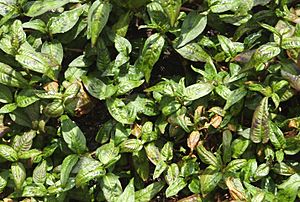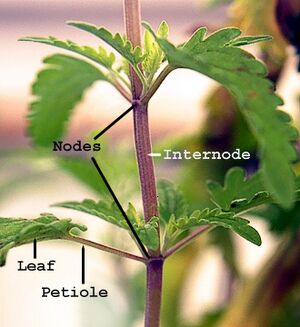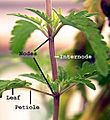Vietnamese coriander facts for kids
Quick facts for kids Vietnamese coriander |
|
|---|---|
 |
|
| Scientific classification | |
| Genus: |
Persicaria
|
| Species: |
odorata
|
| Synonyms | |
|
Polygonum odoratum Lour. 1790 |
|
Persicaria odorata, often called Vietnamese coriander, is a special herb. People also know it as rau răm, laksa leaf, or hot mint. Its leaves are very popular in cooking, especially in countries like Vietnam, Malaysia, and Thailand.
Even though it's called "Vietnamese coriander" or "hot mint," this plant is not related to regular mints or the mint family. It belongs to a different plant family called Polygonaceae. This family includes plants often known as "smartweeds" or "pinkweeds."
Contents
Vietnamese Coriander in Food
This herb is a big part of many tasty dishes. It adds a unique flavor that people love.
Cooking with Vietnamese Coriander
In Vietnamese cuisine, people often eat Vietnamese coriander fresh. You might find it in salads, like chicken salad. It's also a key ingredient in fresh spring rolls called gỏi cuốn. Sometimes, it's added to soups like canh chua or stews, especially fish stews. A very popular way to eat it is with trứng vịt lộn, which is a fertilized duck egg.
In countries like Malaysia, Singapore, and Indonesia, this herb is super important for a spicy noodle soup called laksa. It's so famous there that people often just call it "laksa leaf." Malays also use it in dishes like nasi kerabu and asam pedas.
Other Uses Around Asia
In Cambodia, the leaves are known as chi krasang tomhom. They are used in soups, stews, salads, and Cambodian summer rolls called naem.
If you go to Laos or parts of Thailand, you might see people eating this leaf with raw beef salad, known as larb.
In Manipur, India, the leaves are called phak phai. Some communities there grind the leaves with a very spicy pepper called ghost pepper to make a hot side dish.
Scientists in Australia are even studying the plant to see if it can be a source of useful oils.
What is Vietnamese Coriander Like?
Vietnamese coriander is a perennial plant. This means it lives for more than two years. It grows best in warm, wet places, like tropical areas.
Appearance and Growth
This plant can grow to be about 15 to 30 centimeters (6 to 12 inches) tall. The top of its leaves is dark green and has cool chestnut-colored spots. The bottom of the leaves is a pretty burgundy red. Each leaf grows from a joint on the stem.
You can find Vietnamese coriander growing wild or planted in gardens in Vietnam. It likes sunny spots and soil that drains water well. If you live in a colder place, you can grow it outside in summer. But when winter comes, you should bring it inside like a houseplant. In places with mild winters, it might survive outside, but it won't grow as much. It usually doesn't flower much outside of tropical areas.
Growing Vietnamese Coriander
It's fun to grow your own Vietnamese coriander! It's not too hard if you know what it likes.
Where to Plant It
In places with no frost, like USDA Zones 9-11, you can grow it outside. It likes soil that is not too rich but stays moist. It can handle full sun if there's a gentle breeze and the soil is wet. However, it often prefers a bit of shade, especially under trees.
If winter temperatures drop below 7°C (45°F), you should bring the plant indoors. It needs some humidity to stay healthy inside. In places with milder winters, it can stay outside.
How Big Does It Get?
Vietnamese coriander usually grows about 15 to 45 centimeters (6 to 18 inches) tall and wide. In some places, it can even reach 1 meter (3 feet) tall and 1.5 meters (5 feet) wide in a few years.
This plant is usually quite strong. It doesn't often have problems with pests or diseases. Even deer and rabbits tend to leave it alone!
How to Make More Plants (Propagation)
You can try to grow new plants from seeds in the fall or spring. But it's rare for this plant to flower and make seeds outside of tropical areas.
A much easier way to make new plants is by taking cuttings in the summer. You can even root cuttings in water! If you can't keep the humidity high indoors during winter, it's often easier to buy fresh bunches of the herb from Asian supermarkets in early spring.
Here’s how to do it:
- Take the fresh stems.
- Remove the tiny young leaves at the very top.
- Take off any large leaves along the stems.
- Trim the bottom of the stem just below the first healthy internode (the part of the stem between two leaf joints).
- Put the trimmed stems in water.
- Wait until you see small roots, about 1-2 centimeters (less than an inch) long, growing from the lowest part of the stem.
- Once the roots appear, plant the stems in soil.
- You should be able to start harvesting your own Vietnamese coriander in about two months!
See also
 In Spanish: Coriandro de Vietnam para niños
In Spanish: Coriandro de Vietnam para niños
Images for kids




